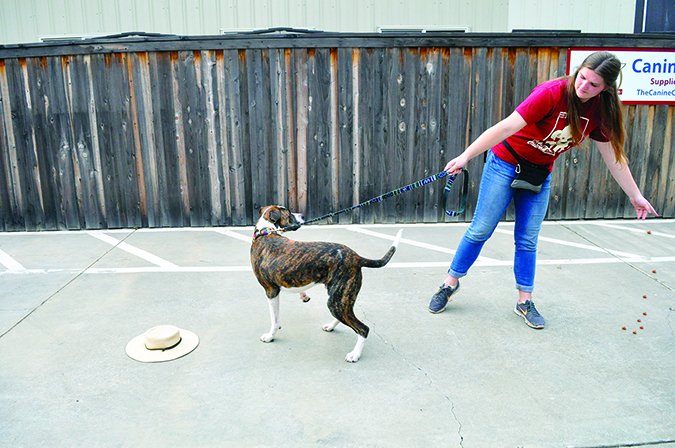This article was originally published as a sidebar to “How to Teach Your Dog To Greet Politely – or Not Greet at All.” The protocol described here was adapted from Kelly Fahey’s Resource Guarding protocol, which was adapted from Chirag Patel’s “Drop” protocol.
Being able to teach your dog to move away from something when asked is an invaluable tool, both for your dog’s safety and for your sanity. Note: Be sure to repeat each step eight to 12 (or more) times, until your dog eagerly responds to the cue before progressing to the next step.
1. Say “Walk Away” in a cheerful tone and toss several treats on the ground six to eight feet behind the dog. Turn and move away with him to encourage him to move quickly. Note: you are trying to get your dog to do a 180-degree turn to get to the treats behind him.
2. Place a neutral (not valuable to the dog) object on the ground. Walk your leashed dog toward it, and when he reaches to sniff it, say “Walk Away!” cheerfully and toss several treats on the ground four to eight feet from the object, behind him. Turn and move away quickly with him, trying to get the dog to do a 180-degree turn away from the object to the treats behind him. Make it a party! Repeat at least eight to 12 (or more) times until your dog immediately and happily moves away from the object in response to the cue. Practice this step with a variety of neutral objects.

3. Repeat Step #2 eight to 12 (or more) times but begin hand-feeding the treats to your dog instead of tossing them on the ground. Continue to move away from the object as you feed him the treats.
4. Place a low-value object (something your dog is mildly interested in) on the ground. When your dog sniffs it, say “Walk Away!” and feed treats from your hand as you and your dog move away from the object. Repeat at least eight to 12 (or more) times until your dog immediately moves away from the object in response to the cue. Practice this step with a variety of low-value objects.
5. Place a medium-value object (to your dog) on the ground. When your dog sniffs it, say “Walk Away!” and feed treats from your hand as you and your dog quickly and happily move away from the object. Make it a party! Repeat at least eight to 12 (or more) times until your dog immediately moves away from the object in response to the cue. Practice with a variety of medium-value objects.
6. Place a high-value object (one of your dog’s favorite things) on the ground. When your dog sniffs it, say “Walk Away!” and feed treats from your hand as you and your dog move away from the object. Repeat at least eight to 12 (or more) times until your dog immediately moves away from the object in response to the cue. Practice with a variety of high-value objects.

7. Place your dog’s empty food bowl on the ground. When your dog sniffs it, say “Walk Away!” and feed treats from your hand as you and your dog move away from the object. Repeat at least eight to 12 (or more) times until your dog immediately moves away from the bowl in response to the cue.
8. Put a handful of low-value food (dry kibble) in your dog’s bowl and place it on the ground. When your dog sniffs it, say “Walk Away!” and feed treats from your hand as you and your dog move away from the object. Repeat at least eight to 12 (or more) times until your dog immediately moves away from the bowl in response to the cue.
9. Put a handful of mid-value (dry kibble mixed with a little canned) food in your dog’s dish and place it on the ground. When your dog sniffs it, say “Walk Away!” and feed treats from your hand as you and your dog move away from the object. Remember to make it a party! Repeat at least eight to 12 (or more) times until your dog immediately moves away from the bowl in response to the cue. Then repeat with high-value food in the bowl.
10. Finally, generalize the Walk Away behavior to other tempting attractions – a cat or squirrel on your walk, the cookie in a toddler’s hand, the greasy fast-food wrapper on the sidewalk, or the playful Poodle that is straining to greet your dog. Who knows? The Poodle’s owner might just ask you how you taught your dog to behave so well, or ask if your dogs could get together for a play-date sometime!





